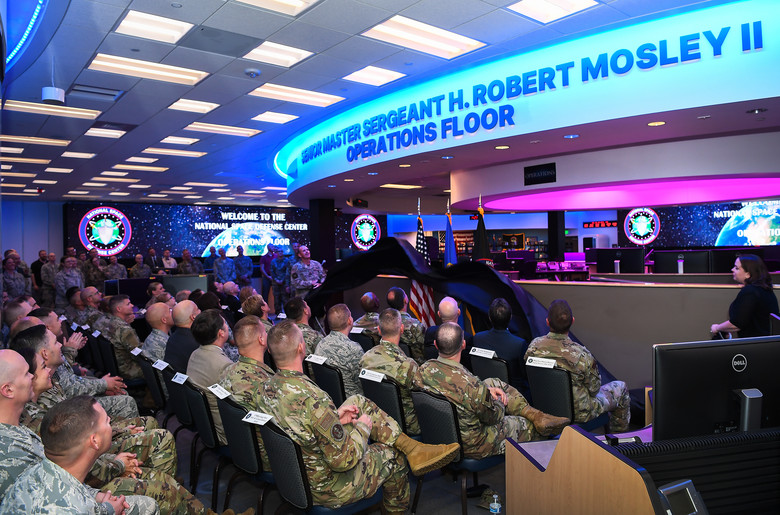
National Space Defense Center, Schriever AFB, Colo.
WASHINGTON: As the US military moves toward All-Domain Operations that require near real-time access to intelligence, surveillance and reconnaissance, the military and the Intelligence Community (IC) are wrestling with challenges of how to seamlessly integrating spy satellite data and operations into Space Command’s networks and command chain.
One of the critical issues is how to ensure assets designed, built, and operated by the National Reconnaissance Office (NRO) — which must meet both IC and DoD requirements sets that sometimes are very different — are linked into the military’s developing Joint All-Domain Command and Control (JADC2) system, NRO and DoD officials say.
“[I]t is fair to say that IC and DoD efforts have not always been aligned optimally, whether in acquisitions or operations, and decision makers recognized a few years ago that there was more that could be – and needed to be done to address emerging threats,” Maj. Gen. Michael Guetlein, the National Reconnaissance Office’s deputy director, said today.
As only Breaking D readers know, DoD and senior military leaders have been pondering whether the time has come to move beyond efforts to better integrate NRO acquisition and operations — an issue that has bedeviled national security space leadership for decades — to actually ending the split between “black and white space” by folding NRO’s acquisition functions into the new Space Force, and its operations into Space Command.
Guetlein spoke at a Mitchell Institute videoconference with Brig. Gen. Tom James, who commands Space Command’s new(ish) Joint Task Force-Space Defense (JTS-SD), designed to conduct space superiority operations. The task force was one of two major subcommands stood up in August by Space Command head Gen. Jay Raymond. It oversees the National Space Defense Center at Schriever AFB, which is where IC and DoD space efforts are integrated.
“While we’re cooperating more than we have any time in the past, we still have several challenges we are wrestling us wrestling with such as overcoming the legacy of the cultural differences between DoD and the IC, as well as between SMC and NRO,” Guetlein said.
Guetlein enumerated four hurdles the Intelligence Community and DoD face as they attempt to re-orient to a new way of warfare — based on linking all sensors to all shooters across all the land, air, sea, space and cyber domains.
- Speed of information. “These two communities have traditionally had two very different approaches to the problem sets we face and operate in vastly different environments and on very different timelines. They can complicate getting the valuable intelligence information data and analysis from the IC to the commanders and warfighters operating at the tactical edge in near real time,” he explained. “One of NRO’s priorities driving forward toward the solution for this challenge is our integrated architecture that will help accelerate the delivery of data we collect to both the warfighter and the IC analysts, making sure they get the data they need, when and where they need it, as fast as they need it,” he added.
- Meeting the new threats. “Another challenge that we are getting after is ensuring our systems are designed to operate in and through a contested environment,” he said.
- Responsibilities for protecting space assets. “Who has the responsibility for defending which elements of the space enterprise and how? This is something Tom and I spend a great deal of time on; we meet every two weeks on this subject alone,” Guetlein said. “In fact, we’re in the process of developing a joint protect and defend [concept of operations] to help guide the future investments in operations.”
- Common standards. Guetlein said that NRO and Space and Missile Systems Center (SMC) are jointly elaborating common technical and data standards, including for JADC2. “We are partnering in the stand up of JADC2, as well as a couple of other C2 systems, to make sure that as those systems come online our data can seamlessly flow into those C2 systems, and be able to get it directly from the sensor to the shooter,” he said. “Today, we’re writing the interface standards to make sure as we build these new next generation systems both sensors and processors that they can all interface seamlessly machine to machine.”
James said that another hurdle is “how we manage the classification of some of our capabilities,” noting that both Vice Chairman of the Joint Chiefs of Staff Gen. John Hyten and Raymond have highlighted the need for reducing secrecy. He said that NRO and DoD need to work through the question of how to declassify information, along with coalition partners, commercial partners and the rest of the US military “so that we’re able to maximize participation to do synchronization for full effect.”
As Breaking D readers know, Raymond has been working with senior DoD leadership to hone a new policy on classification of both DoD’s own space capabilities and adversary threats in order to bolster deterrence.






















